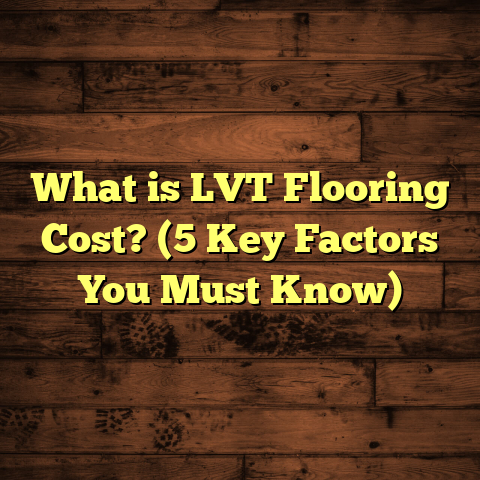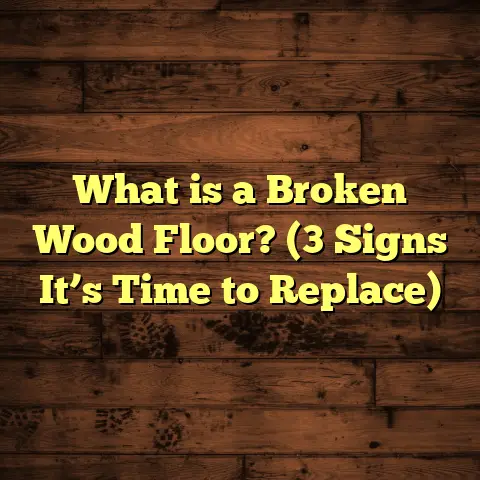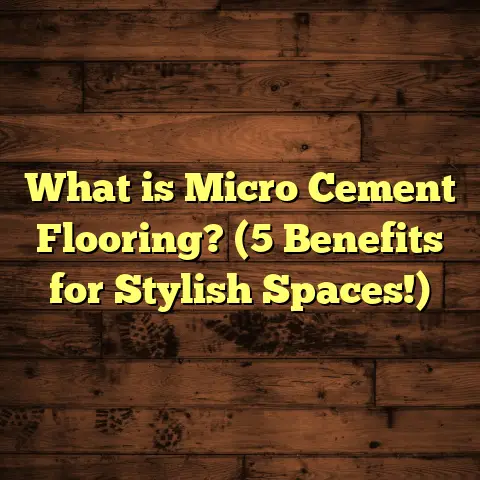What is IVC in Flooring? (5 Key Benefits You Must Know)
Textures shape the way we experience a room. They can make a space feel cozy and inviting or sleek and modern. When I first started working with flooring, I never realized how much the texture beneath your feet could influence not only the look of a room but also how comfortable and practical it is. Over the years, I’ve encountered all sorts of materials, but one type that caught my attention for its unique blend of texture and performance is IVC flooring.
What is IVC in Flooring?
Let’s start with the basics. What exactly is IVC? IVC stands for International Vinyl Company, a major manufacturer of vinyl flooring products. If you’ve shopped for vinyl floors before, you might have seen the brand but didn’t realize just how versatile and high-quality their products are. IVC specializes in luxury vinyl tile (LVT) and luxury vinyl plank (LVP) flooring that combines durability with realistic textures and designs.
The core appeal of IVC flooring lies in its multi-layer construction. Typically, it includes a backing layer for stability, a high-density core layer for strength, a printed design layer that replicates natural materials like wood or stone, and a transparent wear layer that protects against scratches, stains, and everyday wear.
Early in my flooring career, I had a client who wanted the look of hardwood throughout their bustling family home but was worried about maintenance and durability. We installed IVC’s luxury vinyl plank flooring, and it turned out to be a game-changer. The floor looked so authentic that guests assumed it was real wood. More importantly, it held up against spills, pet claws, and heavy foot traffic without fading or scratching easily.
IVC flooring offers the visual charm of natural materials paired with the practical benefits of vinyl, which is why it’s become my go-to recommendation for many projects.
1. Durability That Keeps Up With Your Life
Durability is often the first thing I check when picking a floor for a busy home or commercial space. Vinyl floors can vary widely in quality, but IVC products are known for their tough wear layers that resist scratches and scuffs better than many competitors.
Most IVC flooring options come with wear layers ranging from 12 mils to 30 mils thick. To put that into perspective, 1 mil equals one-thousandth of an inch. The thicker the wear layer, the better protection you get against damage from daily use.
In residential settings, a 12-20 mil wear layer usually does the trick. For commercial spaces like offices or retail stores where foot traffic is heavy, I recommend floors with at least a 28-30 mil wear layer.
Here’s some data from industry reports: Vinyl flooring with a 20-mil wear layer typically lasts 10-15 years under normal residential use. Commercial-grade products with 30-mil wear layers can last beyond 20 years if maintained properly.
I remember one daycare center that installed IVC luxury vinyl tiles five years ago. Despite constant running around, messy art projects, and frequent cleanings with industrial-grade solutions, their floors look almost new today. The staff told me they’ve had minimal repairs and no need for replacement yet.
This durability comes from both the composition of IVC’s core layers and their advanced UV-cured urethane coatings that resist marks and stains. That means less worry about damage from pets’ nails or accidental spills.
2. Water Resistance: No Fear of Spills or Moisture
If you’ve ever owned hardwood floors in a kitchen or bathroom, you know how stressful water exposure can be. Even small leaks can cause boards to warp or stain permanently. That’s why water resistance is a huge selling point for vinyl floors like those from IVC.
All IVC luxury vinyl planks and tiles are designed to be fully waterproof. Unlike laminate or engineered wood that may swell or buckle when wet, IVC flooring can handle standing water without damage.
This quality alone makes it an ideal choice for kitchens, bathrooms, basements, laundry rooms — anywhere moisture might sneak in.
From my experience installing floors in coastal homes where humidity levels soar above 70%, IVC flooring performs exceptionally well. It doesn’t expand or contract much with temperature or humidity changes, unlike natural wood.
A key factor is their use of waterproof cores—either rigid polymer cores or composite cores—that provide dimensional stability even when exposed to water.
There’s also scientific evidence backing this up: studies show vinyl floors maintain structural integrity after prolonged exposure to moisture and do not harbor mold or mildew when cleaned regularly.
One project that stands out involved an apartment complex basement renovation. The previous tile floors had cracked due to moisture underneath. We replaced them with IVC waterproof vinyl planks, and not only did it solve the cracking issue, but residents now enjoy warmer floors with no risk of water damage.
3. Comfort Underfoot That Surprises You
When people think about vinyl flooring, they often picture something hard and cold underfoot—kind of like standing on plastic. But that’s not always true with IVC products.
Thanks to their layered construction and optional cushioned backings, many IVC floors have a surprisingly soft feel that reduces fatigue when standing or walking.
I recall working on a kitchen remodel for a client who spends hours cooking every day. She told me how much more comfortable it was to stand on her new IVC floor compared to previous tile flooring. The slight give in the floor eased pressure on her knees and back.
Some IVC collections feature attached cork or foam underlays that further enhance comfort and reduce noise transmission—a bonus for multi-level homes or apartments.
Sound absorption is often overlooked but plays a big role in how pleasant a room feels. Hard surfaces can create echoes or loud footsteps, which can be tiring over time.
In fact, independent testing shows that luxury vinyl planks with cushioned underlays reduce noise by up to 22 decibels compared to bare concrete or hardwood subfloors.
So if you want a floor that feels good underfoot while keeping things quiet, IVC has options worth considering.
4. Style Options That Match Your Vision
When choosing flooring, texture isn’t just about feel—it’s about how it looks too. That’s where IVC really shines.
Their printed design layers are created using high-definition imaging technology paired with embossing techniques that replicate natural materials down to the tiniest detail.
I’ve installed floors that perfectly mimic the knots and grain patterns of real hardwood, complete with subtle color variations and authentic surface textures you can actually feel under your feet.
For stone-look tiles, the textures capture the roughness or smooth polish of materials like slate or travertine without any coldness associated with real stone.
IVC offers an extensive palette of colors—from warm browns and grays to cool blues and blacks—allowing you to match your décor style precisely.
Beyond textures and colors, plank sizes range from narrow strips to wide planks and even square tiles—giving you creative freedom in laying patterns such as herringbone or chevron without breaking the bank on expensive materials.
I remember one client who wanted a rustic farmhouse look but needed something kid-friendly and easy to clean. We went with an IVC plank featuring a distressed oak texture that nailed the aesthetic while meeting practical needs perfectly.
5. Installation Made Simple
One thing that always surprises new clients about IVC floors is how easy they are to install compared to traditional hardwood or tile.
Many IVC luxury vinyl products come with click-lock systems where planks snap together without glue or nails. This “floating” installation method saves time and allows for some movement beneath the floor without damage.
In my experience, professional installers can lay around 200-300 square feet per day on average with these systems—much faster than glued-down vinyl or ceramic tile installations.
For DIYers, this ease of installation is a huge plus. Most homeowners can handle it themselves if they have basic tools like spacers, utility knives, and tapping blocks.
This speed translates directly into cost savings since labor accounts for roughly 30-50% of total flooring expenses depending on region and job complexity.
One recent project involved replacing old carpet in an office space with IVC LVT using click-lock installation. It took only two days to complete over 1,200 square feet with minimal disruption to business operations.
My Personal Experiences With IVC Flooring
Over the last decade working as a flooring contractor, I’ve installed hundreds of floors across different settings—residential homes, commercial offices, schools, medical clinics—you name it. And whenever clients want something durable but stylish with minimal fuss, I recommend IVC without hesitation.
One memorable project was renovating a vacation rental property near the coast. The owners wanted flooring that could handle sand, saltwater tracked in by guests, and heavy foot traffic without looking worn out after one season. We chose an IVC product with enhanced scratch resistance and waterproof core. After two years, the floors still look fantastic despite continuous use by hundreds of visitors annually.
Another time, during a large hospital remodel, we installed over 5,000 square feet of IVC commercial-grade LVT in patient rooms and corridors. The quietness underfoot combined with easy cleaning protocols made it perfect for healthcare environments where hygiene and noise control are critical.
Data & Statistics You Should Know
To add some numbers into our conversation:
- Wear Layer Thickness: Most residential-grade IVC floors come with wear layers between 12-20 mils; commercial-grade options offer up to 30 mils.
- Lifespan: Residential use typically sees 10-15 years lifespan; commercial products may last 20+ years.
- Water Absorption: Vinyl floors absorb less than 0.05% water compared to over 10% for hardwood.
- Noise Reduction: Cushioned vinyl reduces noise transmission by up to 22 decibels.
- Installation Speed: Click-lock installation can reduce labor time by 30-50% compared to glued-down floors.
These figures highlight why so many homeowners and businesses opt for IVC when they want resilient yet attractive flooring solutions.
Case Study: Office Renovation Using IVC Flooring
Here’s an example from one of my recent projects to give you insight into real-world application:
Project: Mid-sized tech company office renovation
Size: Approximately 4,000 square feet
Flooring Choice: IVC luxury vinyl plank with rigid core
Installation Method: Click-lock floating floor
Duration: Completed in 5 days (including prep)
Challenges: Minimizing downtime during business hours; maintaining acoustic comfort; requiring low maintenance surface
Outcome:
The installation went smoothly thanks to the click-lock system—no messy adhesives meant quick turnaround. Employees immediately noticed reduced noise levels compared to previous concrete floors. Management praised the floor’s ability to withstand heavy rolling chairs and foot traffic without scratching or fading after six months in use.
The project reinforced my belief in how well-suited IVC is for commercial spaces needing durability paired with style and comfort.
How Does IVC Compare With Other Flooring Types?
You might ask: How does IVC stack up against other popular options like hardwood, laminate, or ceramic tile?
Here’s my take based on long-term observations:
- IVC vs Hardwood: Hardwood offers unmatched natural beauty but demands regular maintenance (refinishing, sealing) and suffers from moisture sensitivity. IVC mimics wood aesthetics while providing better water resistance and easier upkeep.
- IVC vs Laminate: Laminate can look similar initially but tends to delaminate or swell when exposed to moisture. Vinyl cores in IVC are waterproof and more flexible underfoot.
- IVC vs Ceramic Tile: Tiles are hard-wearing but cold and unforgiving underfoot; installation is labor-intensive and costly. IVC provides warmth and cushioning while offering quick installation.
By understanding these differences through my projects’ outcomes and client feedback, you get a clearer picture of where IVC fits best in your flooring choices.
Maintenance Tips For Keeping Your IVC Floor Looking New
I always tell clients that while IVC floors are low maintenance compared to wood or tile, some care helps extend their life:
- Sweep or vacuum regularly to remove dirt that can scratch surfaces.
- Use damp mopping with pH-neutral cleaners designed for vinyl floors.
- Avoid abrasive scrubbing pads or harsh chemicals.
- Place protective pads under furniture legs to prevent indentations.
- Clean spills promptly to prevent residue buildup.
Following these simple steps can keep your floor looking great for years without costly repairs or replacements.
Addressing Common Questions About IVC Flooring
People often ask me these questions before deciding:
Q: Is IVC flooring suitable for radiant heating systems?
A: Yes! Many IVC luxury vinyl products are compatible with underfloor heating due to their dimensionally stable cores.
Q: Can it be installed over existing floors?
A: Often yes—IVC floors can be floated over flat surfaces like concrete or wood subfloors without removal of old material if conditions allow.
Q: How does it perform in high-traffic areas?
A: Commercial-grade options with thicker wear layers perform excellently under heavy foot traffic like offices or retail stores.
If you’re curious about anything specific related to your project needs, just ask—I’m happy to share what works best based on my experience.
Final Thoughts
After spending years working hands-on with various flooring types across multiple environments, I’ve come to appreciate how well-rounded IVC flooring is as an option that balances aesthetics, durability, comfort, water resistance, and ease of installation.
Textures matter—they change the feel of your home or workspace profoundly—and with IVC’s realistic embossed finishes combined with practical benefits, you get more than just looks: you get performance tailored for modern living.
If any part of this sounds like what you’re searching for in your next flooring project, giving IVC products serious thought could save you headaches down the road while enhancing your space beautifully.
If you want me to help you pick specific models based on your lifestyle or budget—or even walk you through installation tips—I’m here anytime! Flooring isn’t just about covering surfaces; it’s about creating environments where life happens comfortably every day. And that’s why textures—and materials like those from IVC—matter so much more than we often realize.





